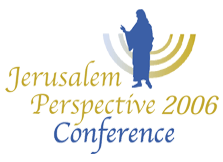Special thanks to Bruce Okkema, who dedicated hundreds of hours to the creation of the videos in this series. This lecture, along with the rest of the presentations delivered at the 2006 Jerusalem Perspective conference, is available through the En-Gedi Resource Center. To purchase the lectures in audio MP3 format, or to purchase the eight-disc DVD set, click here.






